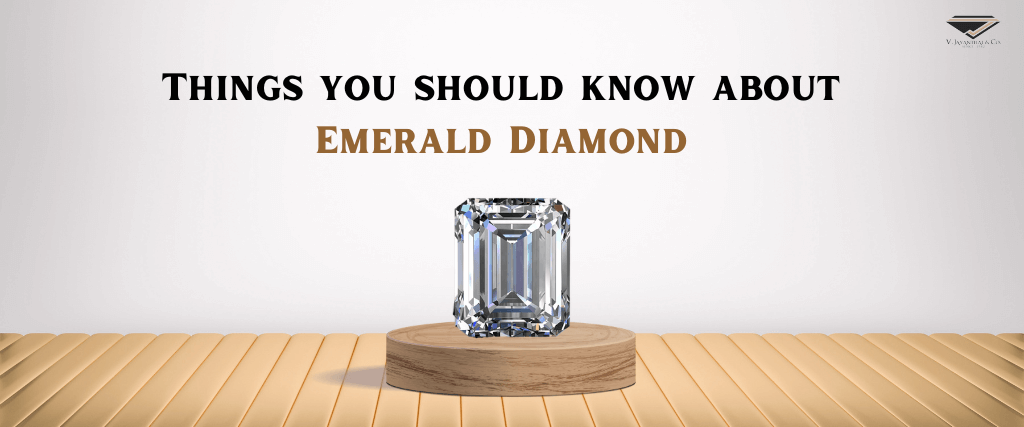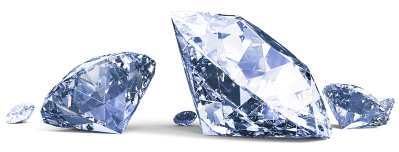
Whether you're treating yourself or shopping for an emerald-cut engagement ring for someone else, look no further for help choosing your perfect emerald-cut diamond! Below, we’ll go over the definition of an emerald-cut diamond and detail what you should consider when shopping for an emerald-cut diamond.
What is an emerald-cut diamond?
Emerald-cut diamonds are step-cut diamonds, meaning they have long parallel facets with a mirrored staircase vibe. When viewed from above, an emerald-cut diamond seems to be a rectangle with rounded sides. Although square emerald diamonds are less common, they still exist. For added durability, the corners of both forms are chopped. It is uncommon to find emerald-cut diamonds in jewellery. An emerald-cut diamond is a popular option for individuals seeking a larger stone without paying a high price point since it typically seems bigger than other shaped diamonds of the same carat weight. Celebrities frequently choose emerald cuts.
How to choose an emerald-cut diamond
Clarity
Our best advice for purchasing an emerald-cut diamond is to realize the significance of clarity for this shape. One of the 4Cs of diamond quality, clarity, is a grade that can reveal a diamond's degree of flaws. When diamonds are created naturally in the crust of the earth, they may be subjected to substances that give them imperfections on the outside or the inside.
With many brilliant cuts, like the round brilliant cut, high clarity isn’t always extremely important. This is because the brilliant cut style features numerous small facets that make it harder to see inside the diamond. On the other hand, emerald-cut diamonds are step-cut with large, linear, open facets. Because it is so simple to see within an emerald-cut diamond, clarity is more crucial. Because of this, many experts recommend making sure your emerald-cut diamond is eye-clean, which means there are no flaws visible to the naked eye.
Generally, VVS1-clarity diamonds and above will be eye-clean. Though you can sometimes find lower-clarity diamonds that are also eye-clean, if the diamond has been given a VVS1, VVS2, or VS1 clarity grade, it will be eye-clean. Additionally, while less frequently found, eye-clean diamonds can be found in grades as low as VS2, SI1, or SI2.
Colour
Diamonds are graded for color from D (colorless) to Z (champagne tones). Just like with clarity, that wide open table on emerald-cut diamonds shows a diamond's color more than with other diamond shapes.
However, keep in mind that each stone's color differs, and in the end, it all comes down to what you adore. Choose what you're drawn to first and worry about the grade second. Often, multiple color grades will look exactly the same to the naked eye.
Not to mention that diamonds are graded by humans, and different diamond graders could give the exact same stone completely different grades - there's an element of subjectivity.
Cut
The true indicator of a diamond's beauty is its cut. A well-cut diamond will shine brightly in direct light and luminize in low light.
The best place to start is to look at factors like polish and symmetry, table (diamond top) percentage, and depth percentage. For guidance on where to start with cut quality, see the table below.
If you're going cross-eyed looking at our chart, book a free consult with us to talk diamonds. You won't need to worry about selecting stones yourself if you're working with us to create bespoke work since we'll choose the most beautiful stone that fits your budget.
Length-to-width ratio
Emerald-cut diamonds can have many different length-to-width ratios. An emerald-cut diamond's proportions can vary, from long and thin to square, depending on this ratio. Since this ratio will provide the traditional emerald-cut diamond appearance, many people believe that a ratio of 1.45 to 1.55 is best for emerald cut diamonds. The "best" or "perfect" emerald-cut diamond ratio does not exist, nevertheless. If you love the look of the elongated shape of a slimmer emerald-cut diamond, go for a higher ratio. Alternatively, if you love the look of a more square-shaped emerald-cut diamond, choose one with a lower ratio.
Why did we choose an emerald-cut diamond?
Angular drama
With a delicious art-deco, Great Gatsby energy, emerald-cut diamonds never lose their luster. They feel eternally modern with their stretched dimensions and crisp geometric lines while nodding to bygone eras with their delicate candlelight shimmer.
Less expensive
Emerald-cut diamonds are about 10–15% less expensive than round brilliant diamonds of the same quality and carat weight.
Why are emerald-cut diamonds cheaper?
Compared to other forms, the emerald cut uses less diamond, saving money and improving sustainability. Also, as a more unique choice, the demand is lower, bringing the price down—a plus for everyone who loves to go against the grain.
Almost unbreakable
Those cut corners are more than just drama; they help prevent damage that can happen with sharp, pointed corners, like on a princess-cut diamond.
So, if you're extra active and want to stay safe, we'd love an emerald-cut diamond for you.
Emerald cuts look bigger
Who doesn't like the idea that an emerald-cut diamond will appear substantially bigger when placed next to a round brilliant diamond of the same carat weight?
Why are emeralds cut longer?
Step-cut stones have less depth than brilliant cuts, so more weight is at the top, making it look larger from above.
Finger flattering
With their elongated proportions, emerald cuts can slim and lengthen the look of your finger when set north-west. We do love an east-west emerald cut, though. Decisions, decisions.
Flash factor
A brilliant-cut diamond sparkles continuously like a disco ball, whereas an emerald-cut diamond occasionally emits blindingly intense bursts of light interspersed with a more subdued brightness. We love a surprise shining moment.
Are emerald cuts more expensive?
The simple answer is no. An engagement ring with an emerald cut will be cheaper than an engagement ring with a round diamond (and cheaper than most other shapes). Compared to other cuts, emerald cuts are much less expensive per carat than round diamonds. This is due to two factors: lower demand for emerald cuts and a higher yield on cutting (you lose the least amount of weight when cutting a rough diamond into a polished emerald cut).
However, things are not that easy. Emerald cuts are less expensive, yes. But when selecting an emerald cut, you also need to be stricter. Emerald cuts do not conceal inclusions as effectively as other cuts because of their glassy nature. When choosing a diamond for one of our readers, we often look for SI1 or SI2 clarity ratings. When choosing emerald cuts, we often go for clarity grades of VS2 or even VS1.
Take a look at this Blue Nile emerald cut. Normally, a diamond with SI1 clarity would be eye-clean. Unfortunately, the inclusion is evident to the human eye because of the huge table and the glass-like appearance. Despite this, emerald cuts are still a good option. We already noted that emerald cuts cost less per carat. Even with improved clarity, you can still find a fantastic deal. Having said that, you may still locate an emerald-cut diamond that is very expensive.
What setting style should I choose for an emerald-cut diamond?
Emerald cuts go well with a variety of settings, but they go especially well with modest ones. Emerald cuts are ideal for three-stone settings and work well with solitaire and simple pave settings.
SOLITAIRE
A well-proportioned Emerald Cut has a "hall of mirrors" look that is amplified by a solitaire setting that allows a lot of light to enter the diamond. It elegantly displays the distinctive design of an emerald diamond. An elegant emerald cut and a simple solitaire setting are very difficult to go wrong with.
See this traditional four-prong solitaire engagement ring with an emerald-cut diamond from Blue Nile for ideas.
PAVÉ
Your ring will stand out more in a pavé setting without pulling attention away from the emerald diamond at the centre. The accent diamonds give the ring some flair while enhancing the fire of the centre stone.
See how the emerald cut might look in a pavé setting in this James Allen tiny pavé engagement ring made of 14K white gold.
THREE STONE
Emerald diamonds look stunning when set in a three-stone design as well. The two lesser stones that are placed on either side of the central emerald help highlight and accentuate its brilliance.
The long, straight facets of the emerald are beautifully contrasted by brilliant-cut diamonds on either side, as in this marquise-shaped three-stone ring by James Allen.
For a sleek and sophisticated appearance, you can also surround the emerald with baguette diamonds, as seen in the example below from James Allen.
Emerald vs Asscher
Asschers and emeralds are the same. The ratio of length to breadth is the only noticeable variation. Asscher cuts are often square, whereas emerald cuts are typically rectangular. There is no distinction between the two in terms of quality or worth. Everything comes down to taste or personal choice. Asscher and emerald cuts are both preferred options for engagement rings and other jewellery. Asscher cuts' square shape gives them a classic feel, while emerald cuts' rectangular shape may produce an appearance that is sleek and exquisite. The choice between the two ultimately boils down to personal preference and the intended visual result.
Diamonds with an emerald cut have an attractive form and distinctive step cuts. For those seeking a larger-appearing diamond without paying a high price, emerald cuts are a fantastic option. You can get emerald-cut diamonds of the highest caliber at V. Jayantilal & Co. for a reasonable price. We advise having a professional inspect your diamond before buying since emerald-cut diamonds need a close examination of the cut quality. Contact our professionals now for help choosing the ideal emerald-cut diamond.







